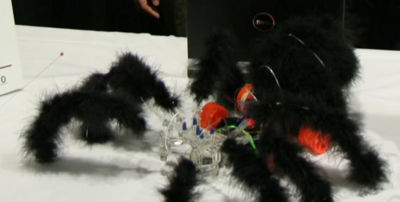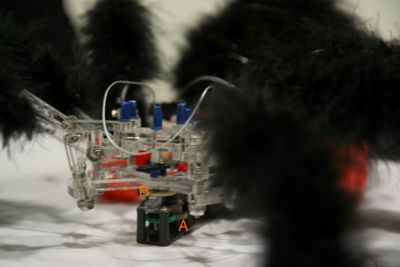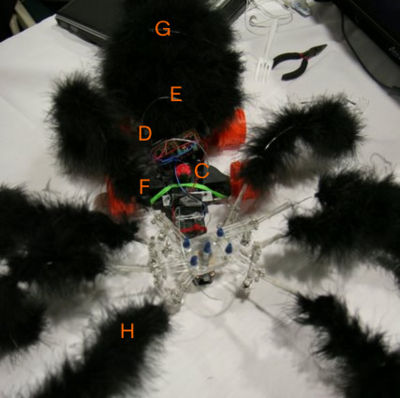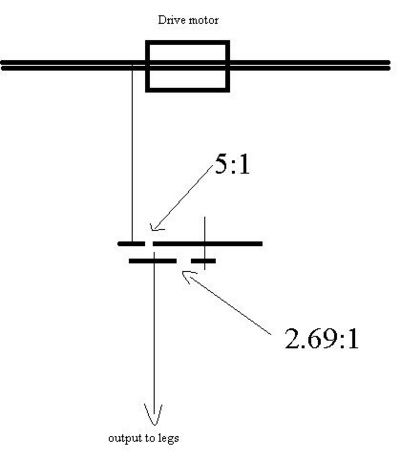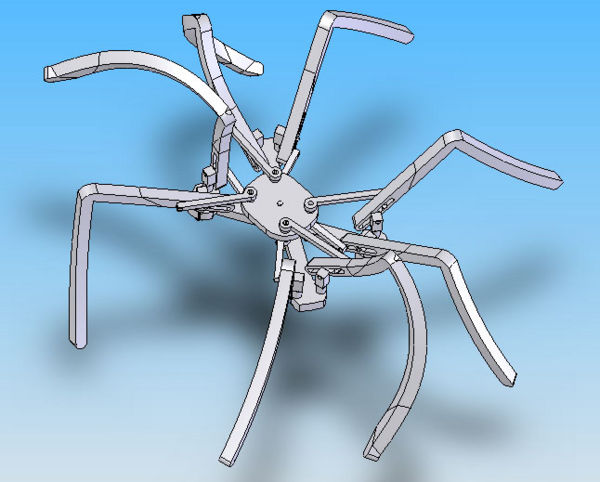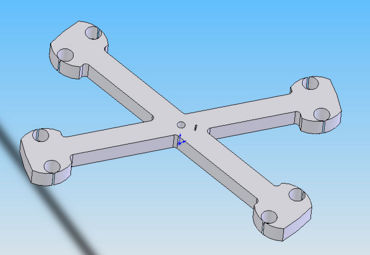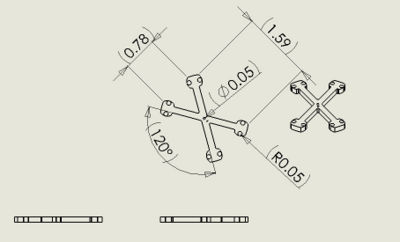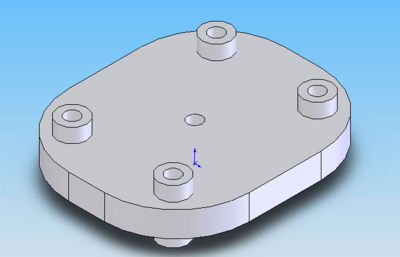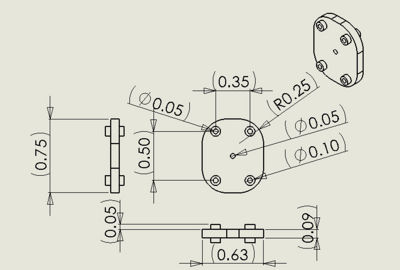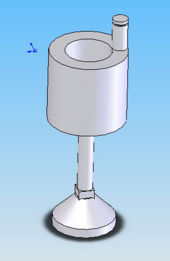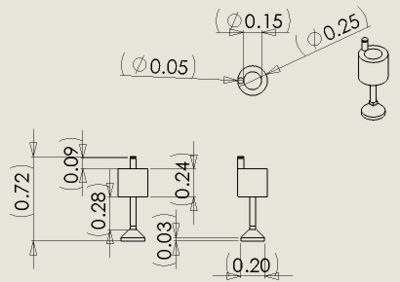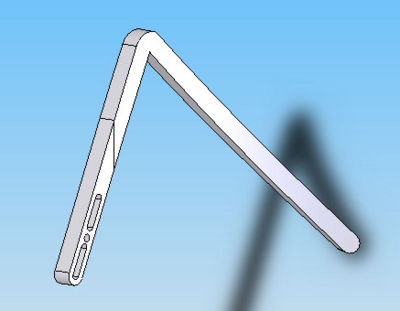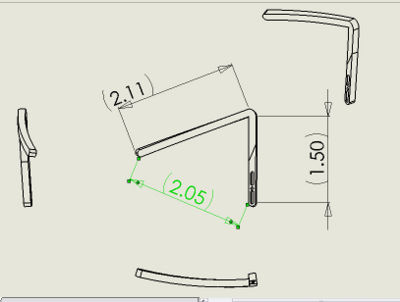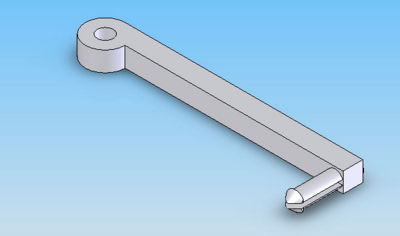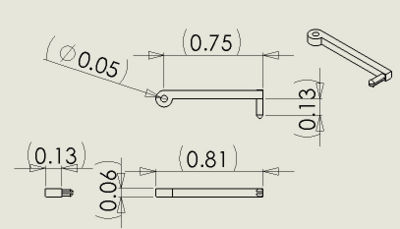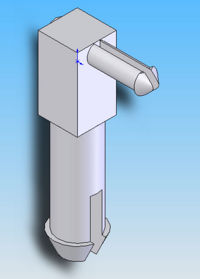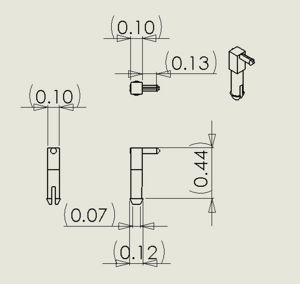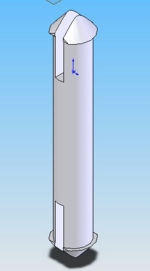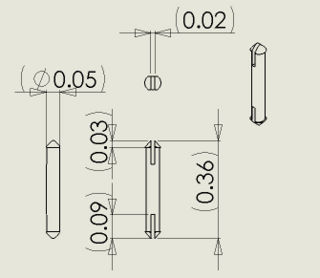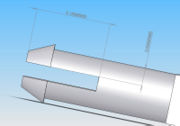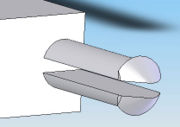Remote control tarantula Final Design
From DDL Wiki
Contents |
Final Report
Executive Summary
The remote-controlled tarantula is a product designed to provide the user with a unique experience, interacting with a semi-realistic toy. Through the dissection of the product, a comprehensive user study, and a market analysis of the models currently being sold, we have gained an understanding of the particular strengths and weaknesses of the product.
The technical capabilities of the remote-controlled tarantula are functional. It has limited mobility, and does not have a great range of application for any of its components. However, the main selling point of the product is its realism. This novel product relies primarily on its portrayal of a tarantula, utilizing its exterior decoration and leg motion to simulate reality.
Through continued analysis of the product and its internal workings, we have come up with a new design that improves upon many of the limitations of the previous iteration. The limited mobility of the tarantula was remedied through the introduction of a more complex control system. By adapting the driving mechanism of a standard RC car, we have increased the ability of the tarantula to travel over various terrains, as well as provide better control. Additionally, we focused on providing more realistic leg motion through the implementation of a more complex rotating cam.
Another area that we investigated and improved upon is the product’s manufacturability. By implementing sturdier materials, we have designed a new set of moving parts for the tarantula that will require less labor intensity in production. By using a stronger material, the tarantula’s internal parts may be composed of snap-to-fit components. This will remove the necessity for various pins and screws to hold the model together. The interaction of these new snap-to-fit components will allow for better maneuverability and maintenance of the product over its lifetime, as well as ensure a long lasting standard of quality.
This new design is a beneficial change from the current iteration for the remote-controlled tarantula. The increase in maneuverability, mobility, and realism provide the user with a more comprehensive and immersive experience. However, these improvements will also require a higher level of production, since the implementation of better materials and components demand that standard. But, by appropriately increasing the range of the product to the $40-$50 market, the product will be able to have access to a larger consumer base that will better appreciate the higher quality product.
There remain steps before the product is ready for production, however. Suitable material must be found for the components, as well as a better apportionment of estate for the internal systems of the tarantula. Also, certain specifications must be met to ensure the safety of the consumer, as well as the functionality of the product over its lifetime. These steps are necessary in order to provide the consumer with the best quality product available on the market.
Background
The remote-controlled tarantula is a product designed to provide the user with the experience of interacting with a semi-realistic toy. The two known existing models being sold commercially for a retail price of $20, and both have extremely similar capabilities. By understanding the qualifications of these two different models, we were able to gain a good sense of the strengths of the product with respect to its target market.
The products currently on market are able to be controlled with two output reactions. When in motion, the tarantula can either move forward or rotate clockwise. The speeds at which these actions are performed depend on the manufacturer. There is a single electric motor controlling the mechanical functions of the tarantula. The drive shaft of the motor engages the wheels, allowing the tarantula to move, as well as providing the necessary power to activate a rotating cam to control leg movement. The wheels of the tarantula are positioned such that there is not much clearance between the ground and the bottom of the model. This feature limits the type of topography that the remote-controlled tarantula can traverse, additionally setting a cap on the speed at which it can travel.
The aesthetics of the remote-controlled tarantula is an important factor in the appeal of the product. Both of the current models depend on providing a sense of realism through different methods. The exterior of the tarantula is coated in a fur-like substance to emulate the outward appearance of an actual tarantula. Similarly, the legs of the products move in a manner simulating the crawling of a tarantula. This cosmetic function is linked to the motion of the tarantula when rotating in place or traveling forward.
This attention to detail to create the illusion of realism is a key focus of the product. In comparison to other remote-controlled toys, the remote-controlled tarantula depends less on its technical capabilities, instead relying on its unique position as a novel item. However, there remain areas that may be improved upon to provide an even more immersive experience for the user.
Areas for improvement were determined through an analysis of the current design, as well as user feedback after interaction with the product. Some of the aspects taken into consideration involved increasing the versatility of the remote-controlled tarantula. Suggestions were made calling for improved speed during rotation and motion of the tarantula. Additionally, the product’s inability to traverse various terrains was another point of interest for some users. Other users asked for the introduction of additional functions such as variable rates of motion, autonomous motion guided by laser pointer, or mandibles with the ability to manipulate small objects.
Statement of Opportunity
The remote-controlled tarantula is a novel product that relies greatly on its aesthetics to appeal to the market. Performance of the product is not as paramount a specification, as it caters to a market that is more concerned with the realism of the model. User testing revealed that while the limitations of functionality were a concern, creating a more immersive experience was preferred. Taking into consideration the importance of the realism of the product, the area of interest for our redesign dealt with an influential component of the user’s experience.
The area of interest that our group decided to focus on was the motion of the legs. The existing system for controlling leg motion was limited to a rudimentary solution that allowed for minimal performance. If left unadjusted, this aspect of the product would detract greatly from the realism of the tarantula.
When the tarantula performs either of its motile functions, the motion of the model engages the mechanism responsible for the movement of the legs. This means that at any time the tarantula is not stationary, the legs will be in a state of motion. So, there is a significant amount of importance placed upon the way in which the legs move. The current design utilizes a rotating cam to interact with the legs, creating an artificial mode of leg motion. The legs are limited to two positions vertically; raised when activated, or lowered when not in contact with the cam. Additionally, the cam is only able to activate legs in sequence as it rotates, limiting the system of legs to a stilted and mechanical performance.
So, the primary focus of this product redesign is to introduce a new system to control the leg motion of the tarantula. Creating a more realistic mode of motion is the main concern, with additional attention given to simplifying the manufacturing process. Doing so will aid in decreasing the amount of labor intensity needed to produce the tarantula, as well as consolidating the necessary materials for production.
Quality Function Deployment
In the description of the remote control tarantula redesign, stakeholder needs were quantified in a list. The stakeholders for this product are defined as entities that are involved at any of the stages of the product life cycle. All of these entities have an economic investment in the product. This includes the end user, as well as the suppliers of the raw material and components necessary to manufacture the finished product.
- Users
- Designers
- Suppliers (Plastic components, electrical assemblies)
- Manufacturers (Toy production/assembly)
- Distributors (Retailers, novelty specialty stores)
For the users, their needs were what we determined during testing. Their list including improving the mobility, traction, speed, turning, leg articulation, cost, and battery life of the original tarantula. As this product is fairly proprietary, and our only direct competition is the original product we were modifying, the benchmarking is essentially just the difference in original design to our new design. To better benchmark our product, We revert back to our original user studies to show the differences In our final design, we focused on the few of these customer needs we felt were most important. When analyzing the customer pool who would purchase the tarantula, we came to the decision that aesthetics and realism were most important to our redesign. In short, if a customer just wanted a fast robot to speed around, they would buy a R/C car – they buy a tarantula for the realism and novelty. On this reasoning, our final design focuses on some targets.
- Multi-directional motion – Our final design utilizes a chassis that allows for forward, reverse, and turning motion in any direction. This is done through the use of a R/C chassis on which the rest of our design is mounted.
- Increased Speed - Related directly to this, the R/C chassis we use will accomplish the requirement of faster motion.
- Traction – Our original design used small, plastic wheels with almost no clearance and no traction. Our final redesign uses offroad-style plastic wheels that are larger with a better wheelbase. These tires are farther apart, have more surface area touching the ground, and stick better.
- Accurate Leg motion – The main focus of our design time, we determined a method of utilizing a single input drive motor to operate the motion of the legs while keeping the motion realistic. This means that alternating legs on each side will move in tandem, and move opposite to their other pairs. This way, at any time 2 legs on a side are lifting and shifting forward, the other two are down and moving backwards, appearing to push the tarantula forward.
In terms of suppliers and manufacturers, our redesign includes methods to simplify purchase of parts along with ease of assembly. Snap fits and repeated parts are the most related issues. Our major interior parts are designed such that they can be injection molded easily. Distributors meet requirements as long as users understand the difference between the original and new tarantula design. They are looking for better sales and profit margin. A better product will lead to this.
Final Prototype
The final prototype was constructed from three main components: a repurposed off-the-shelf remote control car; an off-the-shelf motor and worm gear kit, and a custom acrylic leg mechanism. The remote control car had its external body and middle section removed. The steering was completed by a motor running to a rack and pinion connection on the front wheels. A motor was wired in series with the car’s drive motor, which drove the leg mechanism through an off-the-shelf Tamiya gear box that provided a geardown of 219:1. The leg mechanism was constructed out of laser-cut acrylic, using custom parts designed in CAD software, and installed with a variety of bolts, screws and washers. The power to the motor came from wires running back to the main-R/C car battery pack. This meant our whole design worked on 3 AA batteries mounted in the rear of the robot. Aesthetically, our design left some parts out. Our legs were metal wire with the rigidity to hold their shape. They were glued to the ends of the acrylic leg assembly. Finally, the rear portion of the spider, as well as its legs, was covered with a metal wire mesh shell, constructed of commercially-available florists’ stem wire, covered in black feather boa material, to simulate a furry tarantula body.
Results of Final Prototype
The prototype demonstrated the desired speed, steering, and leg movement of our final product. It was significantly faster than the original, and could be steered left or right, independently of its forward and backward motion. The legs appeared to move individually, true to a real spider’s movement. The prototype’s size was the result of our realization of the difficulties of miniaturizing an engineering design using the tools we had available. We also determined that the grade of acrylic we were using was grossly insufficient for any form of production design. However, we did learn that a complex, eight-leg motion was possible to simulate using only one driving motor and no gearing.
Differences From Final Design
The prototype is several times larger than our desired final product. It’s also constructed from an amalgam of plastics and steel fasteners – our final design would use a single type of plastic, and the only steel components would be a handful of key screws, as well as drive axles. The entire base body of the final design would be molded out of one continuous part, and a cover would be designed for the body of the robot. The legs would be designed out of plastic, as well. Finally, a suitable, fur-like covering would coat the top side of the toy.
Engineering Analysis
Our final engineering analysis covers the motor output of the R/C chassis to the rotational speed of the wheels, and then the gear ratio between that output and the required rotational speed of the leg articulation to correspond to the motion. One of the key parts of the final robot design is that the forward motion of the robot meshes well with the simulated motion of the legs.
Through experimental testing, we determined that our final chassis motor could output a forward speed of around 4-MPH, about human walking speed or slightly faster. This means, with 1-inch wheels, that the output rotation of the rear axle is about
4 miles/hour * 5280 feet/mile * 1/60 hour/minutes * 1/60 seconds/minute = 5.87 ft/sec
Where Pi is the circumference of the drive wheel.
5.87 feet * 12 inches/foot = 70.44 inches
70.44 inches / Pi inches = 22.42 rotations per second
Which is about 1345 rotations per minute.
Through experimentation, the legs must have an articulation rotation speed of about 100 rotations per minute. To meet this discrepancy, the driveshaft running from the drive wheels to the leg articulation must go from 1345 Rot/min to 100 Rot/min. This can be accomplished in 2 steps – first, a 5:1 gear ratio which drops the rotation speed to 269 Rot/minute, and then a 2.69:1 gear ratio, or something very close, to bring the rotation speed down to 100 Rot/minute.
Final Design
General Layout
The following is a general layout of the final design's components. Exact dimensions would need to be finalized; diagram is provided as a basic overview of relative component size and placements. Individual gearboxes would vary depending on function and desired gear ratio.
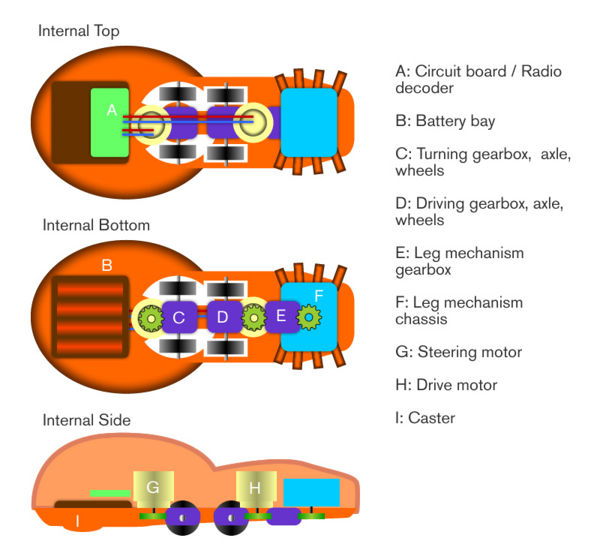
The following is a detail of the cam that drives the overall leg motion of the tarantula.
Bill of Materials
Unique Parts
Base
This component acts as an anchor point for the leg articulation mechanisms. Part is injection molded polyurethane made in a 2-part cast. Acrylic version appears can be found in final prototype.
Center Plate
Linkages from the legs connect to this plate. The plate pivots on the drive shaft, translating but not rotating relative to the rest of the spider. Polyurethane injection molded in a 2-part cast.
Drive Shaft
Component contains three parts, a shaft to transfer power, support ring to maintain proper spacing between parts and a bevel gear which connects to the longitudinal centershaft. Drive shaft is forged and machined steel. At the top of the shaft is a recess which allows for a snap-on anchor. This the use of an anchor removes the possibility of a nut becoming unscrewed due to the rotational motion of the center plate. Ring support and bevel gear are injection molded polyurethane from a 2-part cast. These pieces slip onto the drive shaft and are adhered to it using cyanoacrylate.
Legs
The legs are solid pieces of 2-part cast injection molded polyurethane. The the legs consist of only 2 designs, an "outer" or "inner" leg. The legs are mirrored in two planes to produce both the back/front set and left/right set for 8 total legs.
Linkages
These parts connect to each leg, giving 8 total. Linkages that connect below the center plate are shorter by .25 inches, but other wise are identical. They connect to each leg's sliding joint via the .05 inch snap connection. Each shares a snap pivot with on other linkage to connect it to the center plate and allow for free rotation. This part is injection molded polyurethane from a 3 piece cast (required for the snap joint).
Pin
The pins connect each leg to the base, allowing for rotation in the plane of the ground. These are connected to the legs through the .5 inch snap connection, and connected to the base via the .1 inch snap connection. The 8 pins are made from injection molded polyurethane. The alignment of the slots in the snap joins allow this part to be molded in a 3 part-cast.
Snap Pivot
This part connects an upper and lower linkage to the center plate. The .05 in snap joints on both ends allow for it to be pushed into the center plate first, then attaching the two linkages. This avoids the problem of trying to maneuver the part below the center plate, or having to align both linkages and the center plate simultaneously to insert the part.
Snap Connections
The final design heavily relies on snap connections. These connections reduce the total cost, complexity and assembly time. The flexible thermoplastic allows for for the one time deflection of the snap connection to allow for insertion. Using the guidelines found in the technical bulletin "Snap-Fit Latch Design" by Solvay Advanced Polymers L.L.C. , the snaps were designed. The guidelines give note that the thickness-to-length ratio should be sufficiently great to allow for deflection without fracture, but low enough to prevent permanent deflection. Our design is near the lower bound of the thickness ratio (approximately 4 in the .01 snap), but still within acceptable limits for a one-time snap.
Justification for Production
Ultimately, our redesign should be produced. Our new version’s mobility and realistic simulation of spider movement are vastly better than any other known spider toy on the market. Though our design is of increased complexity, which carries additional parts and manufacturing costs, the added cost simply places us in the middle pricing range of the remote control toy market, as opposed to the original product, which occupies the lowest of the lower end. Our robust feature set would allow us to sell our product to mainstream remote control enthusiasts for a price that they consider reasonable.
Remaining Steps to Production
To bring our design in production, there are many steps remaining that must be taken. A suitable manufacturing plastic must be chosen, as well as an exact scale. The precise size and relative layout of our components, including drive motors, wheels, etc, must be determined. A suitable, fur-like covering would need to be selected, preferably one that does not wear, and is nontoxic/nonallergenic. Battery life and durability testing would be need to be performed, to better gauge the power amount and type we would want to sell to the consumer. The appropriate age group would need to be determined, given the increased product complexity, and basic safety tests would need to be implemented to ensure that the moving legs do not impose a hazard to human fingers (or curious house pets, etc.).
Links
Original proposal can be found at: Remote control tarantula. Redesign can be found at: Remote control tarantula redesign.
